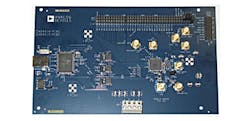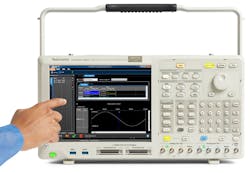Download this article as a .PDF
High-frequency signal sources based on digital techniques include arbitrary waveform generators (AWGs) and direct digital synthesizers (DDSs). Both types of signal sources have gained in frequency and bandwidth over the years, thanks to the enhanced performance of digital components such as digital-to-analog converters (DACs).
AWG- and DDS-based signal sources are both able to create complex output waveforms with high switching speeds, although DDS sources running at high clock frequencies are typically capable of higher-resolution frequency tuning than AWG sources. For that reason, DDS-based sources are often included in AWG designs to provide the benefits of both technologies within a single package.
A Closer Look at AWGs
AWGs, also known as arbs, produce complex user-defined waveforms by converting waveform samples stored in memory to output waveforms in a continuous, point-by-point fashion, using a variable-frequency reference-clock oscillator. The output frequency of the AWG is determined by the reference clock’s frequency, with a waveform sample converted to an output signal for every clock cycle. Each waveform is represented by a given number of samples, taken at different phase angles of a full 360-deg. cycle of the waveform.
Faster clock rates allow the AWG to read more quickly through the waveform samples stored in memory. As a result, for an AWG, faster clock rates generate higher output waveform frequencies. An AWG is a versatile signal source, since any kind of waveform can be stored in its internal memory for processing into output signals. The waveform shape, such as sine wave or square wave, remains constant regardless of the clock frequency.
Digging into the DDS
In contrast, a DDS, also known as an arbitrary function generator (AFG), reads waveform samples stored in memory using a phase accumulator at a fixed clock rate, giving users the ability to choose the samples for creating an output waveform. If a DDS reads every sample for a waveform with a fixed-frequency clock, the frequency of the output waveform would also be fixed. To change frequencies, it reads samples for the phase angles of a waveform, leaving gaps between phase samples. Thus, it uses fewer samples than an AWG to construct an output waveform.
The number of sampled phase points and size of the increments between phase angles determine the length and frequency of a desired waveform. By changing the phase increment, the frequency of a DDS will change instantly. Larger phase increments generate higher frequencies, allowing a DDS to quickly read through fewer waveform samples than an AWG to generate higher-frequency signals. This sampling/synthesis approach also allows a DDS to quickly change waveform configurations, and provide advanced output functions such as digital modulation and frequency hopping as needed.
While it lacks the high-frequency limits of a DDS, an AWG provides much greater control and precision for its generated waveforms. The precision is important for some waveforms, but not for others. For example, signals with continuous shapes, such as sinewaves, are relatively unaffected by large increments between phase angles. But signals with discontinuous shapes or anomalies or transient characteristics—e.g., fast pulse rise and fall times—can be difficult to create accurately with a DDS.
Samples representing transient events that are part of a waveform may not be triggered at a given clock rate and by a given number of samples. It results in an output waveform that is not truly representative of the original sampled waveform.
Since AWGs and DDSs are digital sources, the quality of the reference or sample clock has a great deal to do with the quality of the output waveforms. The number of frequency points available from the sample clock determines frequency precision. As a result, an AWG based on a standard 10-MHz clock oscillator and designed to generate maximum output frequency of 100 MHz will have twice the frequency resolution of an AWG designed for maximum output frequency of 200 MHz using the same clock oscillator. The clock oscillator’s limited number of frequency points are spread across twice the bandwidth in the 200-MHz case, so the resolution is not as fine as for the 100-MHz case.
Selecting Either Source
Both types of signal sources are widely used in test and system applications, chosen for their different performance capabilities. In addition, higher-frequency DDS integrated circuits (ICs) and modular DDS circuits (with supporting components, such as memory and phase accumulators) are available for applications well through the microwave frequency range for programmable radio applications, such as software-defined radios (SDRs).
The AD9850 IC from Analog Devices contains a DAC and voltage comparator on the same chip as the DDS circuitry, using low-power silicon CMOS semiconductor circuitry. It operates at a clock rate of 125 MHz with 32-b tuning word to achieve spurious-free dynamic range of better than 50 dB. In contrast to instrument-grade DDS sources, the AD9850 operates with low power consumption for use in portable devices, including power consumption of 380 mW at 125 MHz and 5 V dc, and only 155 mW at 110 MHz and 3.3 V dc. It comes in a 28-lead SSOP package.
The firm also carries a number of microwave-frequency DDS ICs, including the AD9914 with an integrated 12-b DAC and 3.5-Gsample/s sampling rate. The high-resolution DAC makes possible an output frequency range of dc to 1750 MHz with tuning resolution of 190 pHz and fast frequency hopping. The source exhibits wideband spurious-free dynamic range (SFDR) of better than ‒50 dBc and phase noise of ‒128 dBc/Hz offset 1 kHz from the carrier, with characteristics that suit it for aerospace and defense applications.
The AD9914, equipped with phase-modulation capability, is supplied in an 88-lead LFCSP housing for ease of installation into circuit and system designs. To assist design efforts, the company also offers an evaluation kit for the AD9914 (the EVAL-AD9914), which includes the test board, a datasheet, and instructions on how to set up and use the evaluation board with the AD9914 mounted to it (Fig. 1). For many experimenters, this is a painless first step toward microwave-frequency DDS technology.
For those more in need of test equipment, a number of test-equipment manufacturers produce one or both types of signal sources for laboratory or production testing. For example, the 33600A Series TrueForm AWGs from Keysight Technologies create sinewaves to 120 MHz and pulses to 100 MHz at sampling rates to 1 Gsample/s. These versatile, lower-frequency sources are suitable sources of modulation, with 14-b amplitude resolution and as much as 64-Msample/channel arbitrary waveform memory. Outputs are clean whether gauged in the time domain or the frequency domain, with 1-ps jitter and ‒125-dBc/Hz phase noise, respectively.
For those with a bent toward modular instruments, National Instruments’ 5411 is a 100-Msample/s, 16-b AWG in PXI format. It can create output sinewaves to 43 MHz and output square waves to 25 MHz. It also allows operators to select output impedance by means of software, either 50 Ω for RF testing or 75 Ω for CATV environments. Users can also set output attenuation from 0 to 51 dB.
For those who can’t decide between an AWG or DDS, the AWG4000 from Tektronix functions as both an AWG and a DDS (Fig. 2). In basic DDS mode, the instrument operates at 2.5 Gsamples/s with 14-b resolution and 16 kpoints of arbitrary waveform memory. It can has two channels, each capable of output sinewaves to 600 MHz.
In AWG mode, the AWG4000 has two analog channels and two 16/32-b digital channels with bandwidths to 750 MHz and single-ended or differential outputs. It achieves SFDR of ‒60 dBc and can operate as a continuous signal source, triggered source, sequenced source, and gated source. Its sampling clock can be varied from 100 samples/s to 2.5 Gsamples/s with 14-b vertical resolution. As an AWG, it offers sinewaves to 600 MHz, square waves and pulses to 330 MHz, and arbitrary waveforms to 400 MHz.



